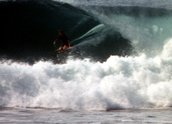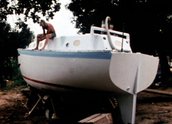


Crystal Voyager (1973)
Synopsis
A surfing biography about legendary design innovator and photographer George Greenough, shot largely in California. Greenough’s search for uncrowded waves drives his construction of a 37-foot ocean-going yacht that he claims is virtually unsinkable. With his surfing friends Richie West, a Californian, and Nat Young, Australia’s world champion surfer, Greenough takes to the cold Californian water, searching for undiscovered waves. The last 23 minutes of the film contains his legendary short film Echoes, composed entirely of extraordinary slow-motion footage shot inside the curl of the waves, the camera in a waterproof housing strapped to his back, with music by Pink Floyd.
Curator’s notes
Crystal Voyager is one of the most beautiful surfing movies ever made, and one of the most successful. It was the first surfing film biography, and the first to concentrate largely on one surfer. Greenough’s innovations had helped revolutionise surfboard design in the 1960s, but the film concentrates on his efforts to capture the perfect surfing footage, from the perfect platform – his own boat.
The film took the surfing road movie, a well-established genre, to the water, with a camera strapped to Greenough’s back. Riding his famous kneeboard – known as 'the spoon’ – Greenough’s footage from under and inside the waves gave the film an extraordinary immediacy.
The final sequence, a 23-minute odyssey, has an almost abstract beauty, aided by an ecstatic song contributed by Pink Floyd. The band had seen his first film, The Innermost Limits of Pure Fun (1970), when it was shown in a Sydney experimental art gallery, The Yellow House. Crystal Voyager was produced and directed by David Elfick, who went on to produce Newsfront.
- Overview
- Curator’s notes
- Video 3 clips

- Principal credits
- Find a copy
- Make a comment
- Reviews 1



